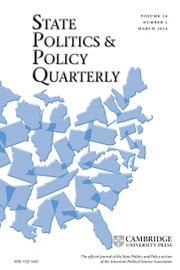No CrossRef data available.
Article contents
State Racial/Ethnic Context and Partisan-Ideological Sorting
Published online by Cambridge University Press: 03 September 2025
Abstract
What role does racial/ethnic diversity in the American states play in racialized partisan and partisan-ideological sorting? We expand the commonly employed empirical frame of Whites’ partisan and partisan-ideological reactions to minority groups at the national level by leveraging the variation in racial/ethnic populations in the American states and accounting for both out-group and in-group size across White, Black, Latino, and Asian respondents. Using the pooled 2012–22 Congressional Election Study, the results demonstrate that Whites tend toward Republican orientations in states with larger Black and Foreign-Born populations and display stronger partisan-ideological sorting in more diverse states with large Black, Latino, or Asian populations. The analyses also reveal that partisan-ideological sorting is asymmetrical along both racial and partisan identities. White partisan-ideological sorting across state racial/ethnic contexts is driven by both Republican and Democratic identifiers, while Black, Latino, and Asian respondents show few signs of elasticity to state context in partisan identity or partisan-ideological sorting. The asymmetries in both PID and partisan-ideological alignment lead to larger racial/ethnic gaps in attachment and alignment in more diverse state contexts. These are well-understood conditions for greater partisan and factional conflict and polarized party and electoral politics.
Keywords
Information
- Type
- Original Article
- Information
- Copyright
- © The Author(s), 2025. Published by Cambridge University Press on behalf of the State Politics and Policy Section of the American Political Science Association

